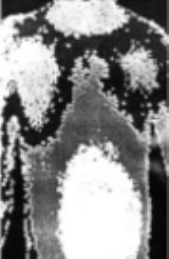
surface temperature and 3) they are prone to low readings because it is
not always evident that the surface thermal connection is adequate.
Body Surface Temperature
Heat signatures vary considerably over the
surface of the human body, and physicians
have long appreciated the relationship be-
tween heat and disease. In fact as early as
400 BC, Hippocrates wrote “In whatever
part of the body excess of heat or cold is
felt, the disease is there to be discovered.”
1
Undoubtedly the earliest use of clinical ther-
mography, Hippocrates found when he cov-
ered his patient’s body with wet clay, the mud
dried quicker on the diseased area, thus pre-
senting a crude but dramatic demonstration
of the heat signatures.
It is impossible to define the surface tem-
perature by any single normal value, since it
is the result of a thermal balance between
energy supplied from the core via perfusion
and energy lost to the environment via radiation, conduction, convec-
tion, and evaporation. All objects, whether animate or inanimate, ho-
meothermic or poikilothermic, radiate electromagnetic energy (radia-
tion) to the surroundings at a rate dependent on its temperature. In
accordance with a basic law of physics, this invisible radiation is con-
stantly emitted, absorbed, and re-emitted by everything in our surround-
ings so that thermal equilibrium can be maintained. A simple example:
left in normal room temperature, a cup of hot coffee quickly cools and a
glass of iced tea quickly warms to the temperature of the room.
If the human eye had the optical power to see the emitted radiation,
which has all the same properties as a beam of light, but differing in
wavelength, all mankind would have an incandescent glow. Because
the temperature over the surface of the human body changes at a rapid
rate in response either to its external environment or to its internal con-
trol mechanism, the incandescence would be quite bright over some
areas and quite dark over others. This variability of the temperature
pattern gives question as to its significance, and yet it is a remarkable
indication of the underlying body physiology.
All biological tissue generates energy in proportion to the metabolic ac-
tivity occurring within the cells. About 80% of the energy developed by
Thermographic scan of
the patient with clay on
his body. (Dorex, Inc. CA)
10


















